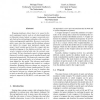Free Online Productivity Tools
i2Speak
i2Symbol
i2OCR
iTex2Img
iWeb2Print
iWeb2Shot
i2Type
iPdf2Split
iPdf2Merge
i2Bopomofo
i2Arabic
i2Style
i2Image
i2PDF
iLatex2Rtf
Sci2ools
CSMR
2005
IEEE
2005
IEEE
Database Wrappers Development: Towards Automatic Generation
Wrapping databases allows them to be reused in formerly unplanned contexts, such as web-based applications or federated systems. Indeed, a wrapper can provide external clients of an existing (legacy) database with a neutral interface and augmented capabilities. However, except in simplistic cases where the wrapper and the database schemas are similar, the wrapper must implement complex mappings: it must translate queries from the wrapper data manipulation language to the database primitives, and, conversely, translate extracted data into the external wrapper format. We have developed a generic schema mapping framework in which wrappers can be specified formally and generated automatically. This framework comprises a highlevel generic data model and a set of schema transformations defined for this model. This reference model makes it possible to specify different data models in a uniform formalism. Mappings between schemas are expressed as sequences of reversible schema transformatio...
CSMR 2005 | External Wrapper Format | Schema Transformations | Software Engineering | Wrapper Data Manipulation |
| Added | 24 Jun 2010 |
| Updated | 24 Jun 2010 |
| Type | Conference |
| Year | 2005 |
| Where | CSMR |
| Authors | Philippe Thiran, Jean-Luc Hainaut, Geert-Jan Houben |
Comments (0)

